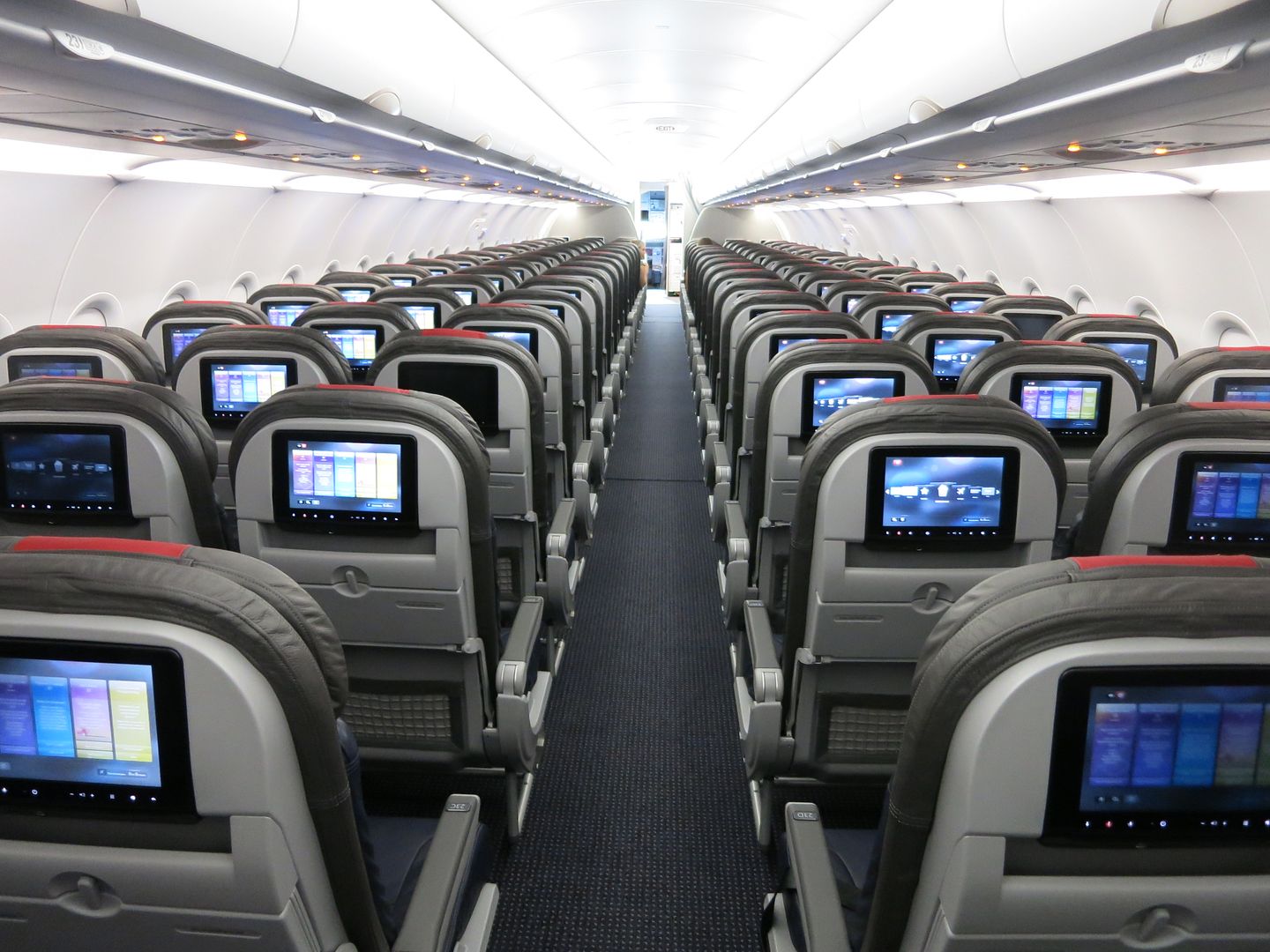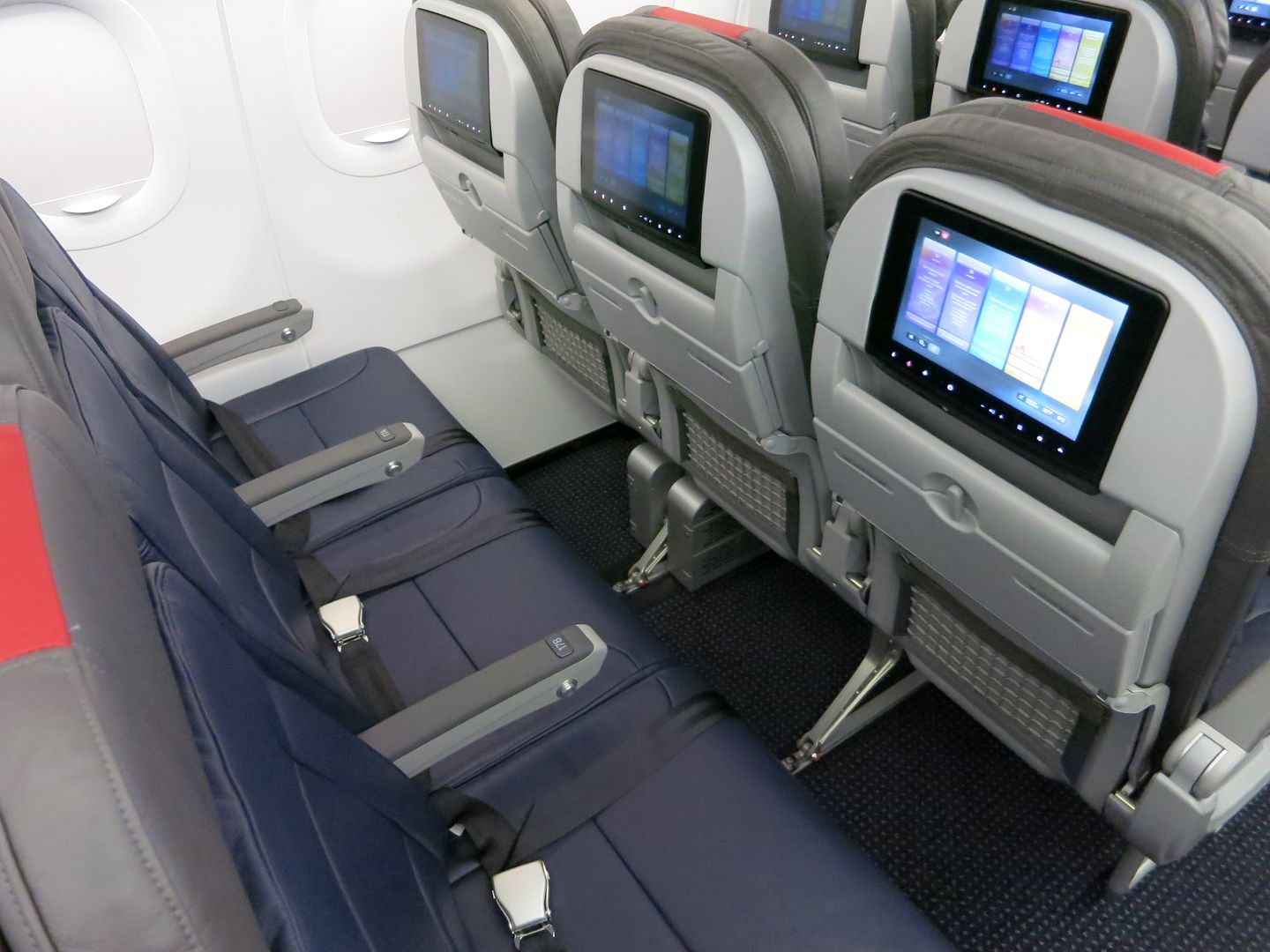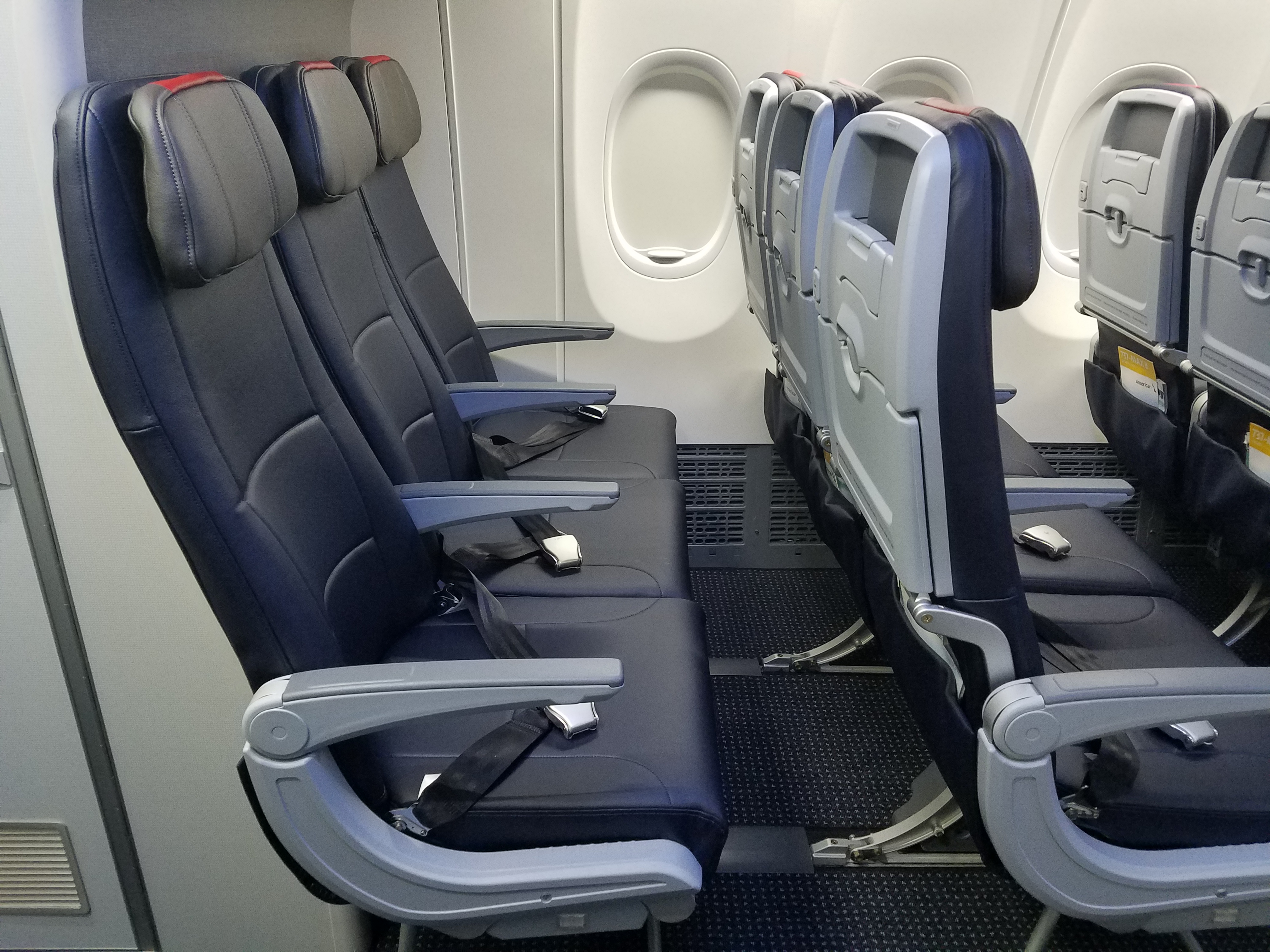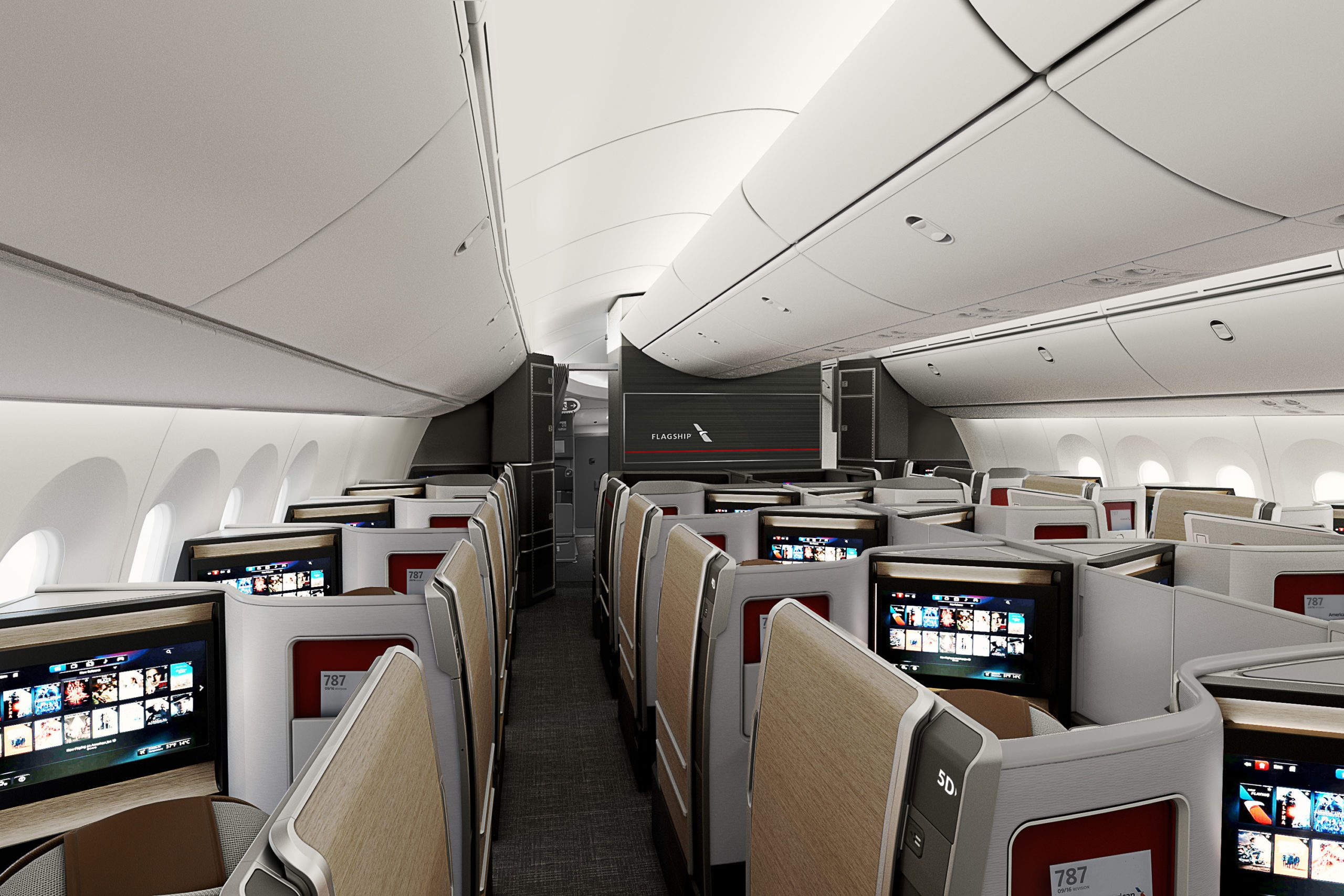For two years American Airlines has been talking about adding first class seats to Airbus A319 aircraft. That finally appears to be happening.
- The planes have only 8 seats up front, compared to 16 on Boeing 737s and 20 on Airbus A321neos.
- American has limited its revenue potential without enough first class seats to sell to passengers. It’s not that upgrades are tough on these planes – buying first class can be tough on many routes.
- However, I’ve said that this project had to wait until they’d finished retrofitting other domestic narrowbody planes (Airbus A321s). The ones American has had in its fleet are done, though they’ll need to make the A321s coming over from Alaska Airlines less comfortable still.

Legacy American Airlines Airbus A319 First Class, With Just 8 Seats And Entertainment Screens
American Plans To Add First Class Seats To Airbus A319s
It looks like the project to add seats – and make other changes – to some Airbus A319s is finally coming to fruition, as reported by aviation watchdog JonNYC.
AA: so the 32 legacy AA A319s are getting Oasis’d and there are rumors about the configuration. One part says the will get the “space flex” (or cabin-flex — whatever it’s called) lavs that go in the back in the galley area.
Some other parts of this, still working on that— JonNYC (@xJonNYC) January 31, 2024
But so yeah, I think the thrust being that adding these lavs in the back equals more first class up front
( so far I only feel the LAA 319s getting oasis + more F is confirmed) pic.twitter.com/2DRVbEQYiJ— JonNYC (@xJonNYC) January 31, 2024
While adding first class seats, American probably doesn’t want to give up total seats. Delta crams four more passengers into their A319s than American does today. So JonNYC says to expect smaller lavatories on those Airbus A319s in order to fit additional first class. I would also expect an inch to be shaved from first class and Main Cabin Extra legroom on these planes, personally. (Jon also says there’s talk of adding first class seats to some Airbus A321s, though this is not confirmed.)
Apparently, per JonNYC, American is only planning to retrofit a subfleet of their Airbus A319s – the ones that had been ordered by American Airlines before being taken over by US Airways management. These have seat back entertainment screens they can pull out.


Putting In American’s Less Comfortable Domestic Product
In 2017 American Airlines began taking deliveries of Boeing 737 MAX 8 aircraft. This was the first plane with the airline’s new signature domestic product: less legroom; less padding in the seats; no seat back entertainment screens; smaller lavatories.. but bigger overhead bins (which help board faster and reduce delays).
Over the coming years American began retrofitting their existing planes into this (“Oasis”) configuration. That meant removing seat back screens from planes that had them. This slapped together project didn’t even get a cabin mockup first. There was so little thought into the product that they had to re-retrofit planes that had already been retrofitted (“Project Kodiak”).

However Airbus A319s never received the treatment. When American Airlines ordered the planes, before being taken over by American, they were already in a dense configuration with more seats than US Airways had had. So they just updated the US Airways planes to match the American Airlines configuration (sans entertainment screens, and without taking the opportunity to add bigger bins).
Some Fleets Still To Be Converted To The Oasis Product
With legacy American Airlines A319s getting the Oasis treatment and more first class seats, that will leave a couple of domestic fleets still untouched since the merger.
- American’s premium cross-country Airbus A321T planes, which is being prototyped now to add seats, remove seat back screens, and convert to a standard domestic product. It’s expected that new American Airlines A321XLR planes with flat bed business class and premium economy will fly similar routes that had been service by these aircraft in the plane.
- American’s basket of deplorable Airbus A320s that still have their old US Airways configuration. They got new seat covers in first class but beneath that are the old, dirty beaten up seats. They don’t have bigger overhead bins or true extra legroom ‘Main Cabin Extra’ seats either.
New Premium Strategy
When US Airways management took over the airline, they came from a carrier that didn’t sell nearly as many business class and first class seats, and when they did sell them it was because they were the low price leader. Their model was mass transportation, and the US Airways stock ticker had even been “LCC.”
A senior executive had told me, right after the merger, that the new premium Airbus A321T would have first class removed. Then they started selling those seats, so the product stuck around for a decade.
They removed business class seats from Boeing 777-200 aircraft. Their Boeing 787-8s have just 20 business class seats, and one is sometimes blocked off for crew rest. And these Airbus A319s have just 8 seats up front. Six years ago, Vasu Raja (now the airline’s Chief Commercial Officer) was complaining he didn’t have enough premium seats to sell.
However the airline has higher costs than a low cost carrier, and increasing costs from new labor deals. They need premium revenue. Both United and especially Delta have done better chasing by chasing premium revenue. And American has announced plans for premium-heavy retrofits of Boeing 777-300ERs and for premium-heavy new delivery Boeing 787-9 aircraft that will get business class suites with doors.

Credit: American Airlines
These new configurations, with fewer seats, also allow the planes to fly further making it more likely that American will add ultra-long haul destinations like Singapore and a return to Hong Kong.
UPDATE: JonNYC says the new legacy American Airlines A319 configuration will be 12 first class and 120 coach seats, which is a net increase of 4 seats. Basically they are adding a row into the aircraft. That was assumed and I’d have been shocked if it were otherwise.
The question is where those inches come from. Some will come from the lavatory. But I’d expect some to come from legroom from existing seats, both first class and economy.


I’m guessing that the ex-US A319s and A320s are destined for retirement soon. That’s probably what the rumored narrowbody order will replace. It’s always easy to spend other people’s money. Two questions: When did airlines adopting somewhat different business models become a felony? And why do your articles usually seem to imply that you want to see American liquidated?
What about the middle life 319’s they acquired from Frontier? Those aren’t as old as the LUS fleet.
I can’t remember seeing seatback screens on a 319 (or 320). But Gary: I am confused about AA’s plans for the 321T: are they keeping flatbeds to JFK and BOS or replacing them with seats? I fly AA to the east coast for that reason; otherwise I would go United (which has beds in its widebodies).
Ian – they’re not getting rid of flat beds on premium transcon. Eventually they will replace the transcon 321s with new 321 ‘XR’ aircraft that have flat beds
… and the XLR will have more total seats while reducing the percentage of seats that are “premium” and cut fuel costs by using a NEO instead of the CEO. The reason the A321T doesn’t work financially is that it has too few total seats, partly necessary because the A321CEO struggles to make a transcon flight in the winter under severe headwinds while the NEO should be able to easily do it, esp. as an XLR.
The A321T strategy was conceived before JetBlue introduced Mint which brought down transcon fares. The economics of premium transcon are not as favorable as it was before but there are a higher percentage of passengers that are willing to pay for it than on other domestic routes.
As for adding more premium seats on the 787-9 and 777-300ER to get more range, the economics simply won’t work even though UA also is supposedly considering further reducing the number of seats on its 787-9 and add even more business class seats. A high percentage of costs on ultra long haul aircraft is crew and fuel costs. The big 3 all pay roughly the same amount for pilot costs and they also pay widebody pilots the same amount regardless of the aircraft flown. Taking seats off of an aircraft increases the pilot cost per passenger. UA already has just 265 seats on its 787-9s; taking seats off could push that number closer to 240 which is a very low number to make an ultra long haul flight work at US airline labor costs. AA has room to go down to what UA has now but they will be competing against UA’s 777-300ERs at 350 seats and DL’s A350-900s and -1000s which have and will have more favorable labor costs per seat .
Fuel burn goes up disproportionately on ULH flights and the cost per passenger will also go up as you remove seats while the weight doesn’t go down much. Both versions of the A350 are more fuel efficient per passenger at ULH ranges because of their higher seat count.
And the 777-300ER at AA’s seat configuration is simply not an economical aircraft. UA undoubtedly makes more money flying DEL-EWR on a 787-9 than AA does flying DEL-JFK because of the much higher fuel cost.
Airlines can and are tweaking their narrowbody configurations but there are some certain limitations to longhaul flying that are related to each aircraft; the 787 and 777-300ER are simply much less cost efficient than the A350 or even the 777X and AA and UA simply don’t have either of those two models.
You certain go out of your way to bash AA at every juncture with lots of misinformation. Hopefully no one really takes your criticisms seriously because I SAH do not. I hope if you ever board an AA Flight that the Ground Staff and Crew are aware of who you are and treat you accordingly. ^ You must be one bitter Queen after having your Advantage account purged.
roger,
not sure who you are addressing but, if it is me, I am not bashing AA. I am talking about general aircraft economics and it is just as relevant to UA as it is to AA other than the configuration of the 777-300ER.
And my AA account is active and I have flown them in the past few months. They treated me just fine on the ground and in the air.
AA’s oasis configuration is notable in that it’s the only domestic first class seat I’ve ever occupied where the legroom was barely enough and which was actually uncomfortable for a 3 hour flight (ORD-PBI). Economy must be absolute hell on their aircraft.
This is good news for PTY, which is currently served only with A319s
AA flying to Singapore is a pipe dream. Let’s just look at their hubs and where they could realistically do it from: JFK, SEA (if that’s still a hub of theirs), LAX, and DFW.
NYC is heavily served by SQ already, with 2 daily non-stops that are only feasible with the A350-900 ULR and the JFK-FRA-SIN 1-stop. We know AA doesn’t like to compete against Asian carriers (or in general). So NYC is not likely.
LAX is also heavily served by SQ already, with 10 weekly non-stops and the LAX-NRT-SIN 1-stop. Again, AA doesn’t like competition. UA couldn’t make LAX-SIN work even though they’re generally stronger in APAC and theoretically could get some connecting traffic on both ends while AA only on the LAX end, though AA is stronger than UA at LAX.
SEA is not even served daily by SQ, only 3x weekly, because there’s not really enough demand to fill a lot of seats, and domestic feed that would be provided by AS is also siphoned off by SQ.
DFW is not served by SQ, but IAH is and geographically speaking, it’s basically the same distance from SIN. SQ only serves IAH 3x weekly (currently, to be upgraded to 5x weekly soon) and with a stop in MAN. The flight is too far for a non-stop to be economical even for SQ with the A350-900 ULR.
Let’s stop suggesting these prestige ULH routes by AA are remotely possible, the economics don’t work and management is too timid to try something like that. It’s a pipe dream. AA is going to use the retrofitted 787s and 777s to put additional premium capacity primarily on routes they already serve where they know there is demand, which are primarily partner hubs where they can get feed from both ends.
I’m an AA million miler. I control enough spend at the moment that my wife became a UA Premier gold last year (equal to AA plat).
Now that BA has gutted the sweet spots in their award chart, I’m not sure when I will ever fly AA again, unless it’s a feeder route where they have an exclusive. Certainly not cash travel LA to Tampa, NYC, Chicago, BOS, which is a lot of our travel.
AA is proving the impossible, that you can in fact “fall off the floor”
And I have to quibble with one point. I would take the old 762 over the 321Ts any day. “Best plane in the fleet” my ass. Transcon coach on the 321T is terrible. If an E175 could make the trip Id do it in a heartbeat over the 321t config.
Dominic,
UA could not do LAX-SIN on the 787 because it was consistently payload restricted during parts of the year.
Even at 265 seats, the 787-9 for UA cannot consistently do 17 hour flights w/o payload restrictions. LAX-SIN is a 17 hour flight for large parts of the year and often longer than that.
While Boeing is working on a MTOW upgrade to the 787-9 that might add up to an hour of range, SQ has been operating LAX-SIN with a 253 seat A350 (not their ULR w/ 160 seats) and the aircraft SQ uses on LAX-SIN are 280 tonne MTOW aircraft, not even 28e tonne the highest MTOW versions.
There is one US airline that has eight A350-900s with 280 tonne MTOWs and 16 more on order with 283 tonne, which will also come in a 275 seat configuration. Those latest aircraft should be more than capable of flying LAX-SIN by the airline that happens to be the largest at LAX if that airline chooses to launch the route. Their execs have told employees they are interested in a return to SIN but operating nonstop from the US instead of via their previous Tokyo hub.
Tim,
My previous reply was strictly an analysis of whether AA would actually fly to Singapore. Good job inserting Delta into the conversation where it did not belong, as usual. The fact that the new A350s can do LAX-SIN without blocking off seats is entirely irrelevant, because AA does not have them and did not order them. Thus, LAX-SIN is as unviable for them as it was for UA from an aircraft perspective.
But on the Delta note, do you really think Delta has a high likelihood of flying to Singapore with the new A350s? Delta, as you constantly note, has pulled back on Asia flying over time with a focus on more profitable flying and funneling other traffic through ICN on KE. The only real ultra-long haul routes that Delta flies are to JNB and CPT, where there’s only 21 weekly flights from all of the US to South Africa and routing through ATL saves significant time vs connecting in Europe. The 3 other longest routes (which are not that long compared to the longest flights out there) that DL flies are ATL-ICN (hub-hub), DTW-PVG (hub-hub) and LAX-SYD. The only place where DL does ultra-long haul is for a route with limited and fixed competition (really UA’s South Africa routes), do you really expect that they’ll just dive into LAX-SIN? And if not, it would be SEA-SIN, which again SQ can only make work 3x weekly despite having feed on both sides vs DL only having feed on the Seattle side. So while my previous analysis was for AA, I would also note that the LAX-SIN prestige ULH route is a similar pipe dream for Delta, even with their higher MTOW A350. It might be feasible for the aircraft, but it really doesn’t fit into their business strategy from LAX and it’s not really a viable route from SEA
Glad to see them adding another row of F. You have a better chance at winning the lotto than scoring an upgrade on an A319. Sad to see the screens go but they’re getting long in the tooth and don’t offer live TV. Many of the LAA A319s I’ve been on lately have had finnicky screens and/or remotes.
My guess is that the with the next NB order AA will go back to adding screens. Doesn’t make sense to do it with the LUS Airbuses being close to retirement and the A321s/737s just getting retrofitted. But by the time the new NB planes are being delivered it’ll be time to do a cabin refit on the Kodiak’ed planes.
As someone who pays to sit in the pointy end, the A319 developments are highly disappointing. The IFE was great, and having only 8 seats dramatically increased the odds of a PDB. The F seats were also better cushioned than the rest of the AA fleet. Now these aircraft will have more of the hard “big front seats” that adorn the domestic fleet. Gross.